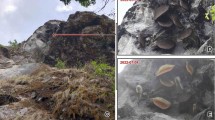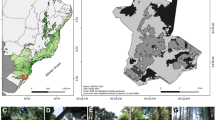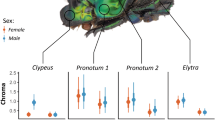Abstract
Phytophagous insects are excellent model organisms to study the genetic and ecological components of adaptation and morphological divergence, because their host plants are one of the main environmental factors influencing their early life stages. Although many lepidopterans are highly specialized in their host use, shifts to exotic plants have been reported for some species. Macaria mirthae is a native moth from Northern Chile that feeds preferentially on the Fabacea species Acacia macracantha, however due to habitat loss a host shift has recently been observed to the introduced fabacean Leucaena leucocephala. We studied the impact that different host plants have on the developmental instability levels in the moth’s wing morphology evaluating both fluctuating asymmetry (FA) and directional asymmetry (DA). FA measures the small random deviations existing between the left and right sides of bilaterally symmetrical traits and it widely used as a biomonitor of environmental quality. DA refers to the tendency for a trait to be consistently developed in a different manner on the right and left sides of the body. It has been recently shown that subtle DA patterns seem to be a ubiquitous phenomenon among bilaterian animals. Our results confirmed the presence of FA in M. mirthae forewings by applying geometric morphometric techniques. Furthermore, it was found that the individuals feeding on the endemic tree (A. macracantha) showed marked DA levels, while the specimens inhabiting the exotic plant (L. leucocephala) did not. The absence of DA in the individuals occupying the exotic plant is striking, because it has been established that this asymmetry pattern is widespread among insect wings. This phenomenon could be related to the influence of L. leucocephala on normal wing development. Despite the reduced quality of L. leucocephala as host plant, its wider presence in the Azapa valley (Chile) could explain the host shift made by M. mirthae.



Similar content being viewed by others
References
Aronson J (1991) Description and distribution of Acacia macracantha Humb et Bonpl ex Willd. (Leguminosae, Mimosoideae) in northern Chile. Gayana Bot 48:81–88
Auffray J-C, Alibert P, Renaud S, Orth A, Bonhomme F (1996) Fluctuating asymmetry in Mus musculus subspecific hybridization. Advances in morphometrics. Springer, New York, pp 275–283
Auffray J, Debat V, Alibert P (1999) Shape asymmetry and developmental stability On growth and form: spatio-temporal pattern formation in biology. Wiley, Chichester, pp 309–324
Benítez HA, Parra LE (2011) Fluctuating asymmetry: a morpho-functional tool to measure development stability. Int J Morphol 29:1459–1469
Benítez H, Briones R, Jerez V (2008) Fluctuating asymmetry in two populations of Ceroglossus chilensis (Eschscholtz, 1829) (Coleoptera: Carabidae) in agroecosystem of Pinus radiata d. Don, Bio–Bio region, Chile. Gayana 72:131–139
Bookstein FL (1991) Morphometric tools for landmark data: geometry and biology. Cambridge University Press, Cambridge
Boorman CJ, Shimeld SM (2002) The evolution of left–right asymmetry in chordates. BioEssays 24:1004–1011
Carreira V, Soto I, Hasson E, Fanara J (2006) Patterns of variation in wing morphology in the cactophilic Drosophila buzzatii and its sibling D. koepferae. J Evol Biol 19:1275–1282
Coyne JA (1987) Lack of response to selection for directional asymmetry in Drosophila melanogaster. J Hered 78:119
Coyne JA, Orr HA (2004) Speciation, vol 37. Sinauer Associates, Sunderland
Dambroski HR, Linn C, Berlocher SH, Forbes AA, Roelofs W, Feder JL (2005) The genetic basis for fruit odor discrimination in Rhagoletis flies and its significance for sympatric host shifts. Evolution 59:1953–1964
De Coster G, Van Dongen S, Malaki P, Muchane M, Alcántara-Exposito A, Matheve H, Lens L (2013) Fluctuating asymmetry and environmental stress: understanding the role of trait history. PLoS One 8:e57966
Debat V, Alibert P, David P, Paradis E, Auffray J-C (2000) Independence between developmental stability and canalization in the skull of the house mouse. Proc R Soc Lond B Biol Sci 267:423–430
Dryden I, Mardia K (1998) Statistical shape analysis. Wiley, Chichester
Etges WJ, Veenstra CL, Jackson LL (2006) Premating isolation is determined by larval rearing substrates in cactophilic Drosophila mojavensis. VII. Effects of larval dietary fatty acids on adult epicuticular hydrocarbons. J Chem Ecol 32:2629–2646
Floate K, Fox A (2000) Flies under stress: a test of fluctuating asymmetry as a biomonitor of environmental quality. Ecol Appl 10:1541–1550
Fogleman JC, Abril JR (1990) Ecological and evolutionary importance of host plant chemistry. Ecological and evolutionary genetics of Drosophila. Springer, New York, pp 121–143
Fraser SM, Lawton JH (1994) Host range expansion by British moths onto introduced conifers. Ecol Entomol 19:127–137
Graham JH, Freeman DC, Emlen JM (1993) Developmental stability: a sensitive indicator of populations under stress. ASTM Spec Tech Publ 1179:136
Graham JH, Emlen JM, Freeman DC, Leamy LJ, Kieser JA (1998) Directional asymmetry and the measurement of developmental instability. Biol J Linn Soc 64:1–16
Graham JH, Raz S, Hel-Or H, Nevo E (2010) Fluctuating asymmetry: methods, theory, and applications. Symmetry 2:466–540
Graves SD, Shapiro AM (2003) Exotics as host plants of the California butterfly fauna. Biol Conserv 110:413–433
Hammond AC (1995) Leucaena toxicosis and its control in ruminants. J Anim Sci 73:1487–1492
Hawthorne DJ, Via S (2001) Genetic linkage of ecological specialization and reproductive isolation in pea aphids. Nature 412:904–907
Jahner JP, Bonilla MM, Badik KJ, Shapiro AM, Forister ML (2011) Use of exotic hosts by Lepidoptera: widespread species colonize more novel hosts. Evolution 65:2719–2724
Jones CD (1998) The genetic basis of Drosophila sechellia’s resistance to a host plant toxin. Genetics 149:1899–1908
Jones C (2004) Genetics of egg production in Drosophila sechellia. Heredity 92:235–241
Jorge LR, Cordeiro-Estrela P, Klaczko LB, Moreira GR, Freitas AV (2011) Host-plant dependent wing phenotypic variation in the neotropical butterfly Heliconius erato. Biol J Linn Soc 102:765–774
Kark S, Lens L, Van Dongen S, Schmidt E (2004) Asymmetry patterns across the distribution range: Does the species matter? Biol J Linn Soc 81:313–324
Kircher H (1982) Chemical composition of cacti and its relationship to Sonoran Desert Drosophila. In: Barker JSF, Starmer WT (eds) Ecological genetics and evolution: the cactus–yeast–Drosophila model system. Academic Press, Australia, pp 143–158
Klingenberg CP (2002) Morphometrics and the role of the phenotype in studies of the evolution of developmental mechanisms. Gene 287:3–10
Klingenberg CP (2003) Developmental instability as a research tool: using patterns of fluctuating asymmetry to infer the developmental origins of morphological integration. In: Polak M (ed) Developmental instability: causes and consequences. Oxford University Press, New York, pp 427–442
Klingenberg CP (2004) Integration, modules and development: molecules to morphology to evolution. In: Pigliucci M, Preston K (eds) Phenotypic integration: studying the ecology and evolution of complex phenotypes. Oxford University Press, New York, pp 213–230
Klingenberg CP (2011) MorphoJ: an integrated software package for geometric morphometrics. Mol Ecol Res 11:353–357
Klingenberg CP, McIntyre GS (1998) Geometric morphometrics of developmental instability: analyzing patterns of fluctuating asymmetry with procrustes methods. Evolution 52:1363–1375
Klingenberg CP, Monteiro LR (2005) Distances and directions in multidimensional shape spaces: implications for morphometric applications. Syst Biol 54:678–688
Klingenberg CP, McIntyre GS, Zaklan SD (1998) Left–right asymmetry of fly wings and the evolution of body axes. Proc R Soc Lond B Biol Sci 265:1255–1259
Leamy LJ, Klingenberg CP (2005) The genetics and evolution of fluctuating asymmetry. Annu Rev Ecol Evol Syst 36:1–21
Lens L, Van Dongen S, Kark S, Matthysen E (2002) Fluctuating asymmetry as an indicator of fitness: Can we bridge the gap between studies? Biol Rev 77:27–38
Lewontin RC (2000) The problems of population genetics evolutionary genetics: from molecules to morphology. Cambridge University Press, Cambridge, pp 5–23
Ligoxygakis P, Strigini M, Averof M (2001) Specification of left–right asymmetry in the embryonic gut of Drosophila. Development 128:1171–1174
Lowe S, Browne M, Boudjelas S, De Poorter M (2000) 100 of the world’s worst invasive alien species: a selection from the global invasive species database. Invasive Species Specialist Group Species Survival Commission, World Conservation Union (IUCN), Auckland
Luebert F, Pliscoff F (2006) Sinopsis bioclimática y vegetacional de Chile. Editorial Universitaria, Santiago, Chile, 316 pp
Marohasy J (1996) Host shifts in biological weed control: Real problems, semantic difficulties or poor science? Int J Pest Man 42:71–75
Matsubayashi KW, Ohshima I, Nosil P (2010) Ecological speciation in phytophagous insects. Entomol Exp Appl 134:1–27
Matsubayashi K, Kahono S, Katakura H (2011) Divergent host plant specialization as the critical driving force in speciation between populations of a phytophagous ladybird beetle. J Evol Biol 24:1421–1432
Méndez-Abarca F, Mundaca EA, Vargas HA (2012) First remarks on the nesting biology of Hypodynerus andeus (Packard) (Hymenoptera, Vespidae, Eumeninae) in the Azapa valley, northern Chile. Rev Bras Entomol 56:240–243
Møller AP (1997) Developmental stability and fitness: a review. Am Nat 149:916–932
Møller AP, Swaddle JP (1997) Asymmetry, developmental stability and evolution. Oxford University Press, Oxford
Monedero JL, Chavarrïas D, Löpez-Fanjul C (1997) The lack of mutational variance for fluctuating and directional asymmetry in Drosophila melanogaster. Proc R Soc Lond B Biol Sci 264:233–237
Mozaffarian F, Sarafrazi A, Ganbalani GN (2007) Host plant-associated population variation in the carob moth Ectomyelois ceratoniae in Iran: a geometric morphometric analysis suggests a nutritional basis. J Insect Sci 7:1–11. doi:10.1673/031.007.0201
Nijhout H, Davidowitz G (2003) Developmental perspectives on phenotypic variation, canalization, and fluctuating asymmetry. In: Developmental instability: causes and consequences. Oxford University Press, UK, pp 3–13
Nylin S, Nygren GH, Söderlind L, Stefanescu C (2009) Geographical variation in host plant utilization in the comma butterfly: the roles of time constraints and plant phenology. Evol Ecol 23:807–825
Ohshima I (2008) Host race formation in the leaf-mining moth Acrocercops transecta (Lepidoptera: Gracillariidae). Biol J Linn Soc 93:135–145
Palmer AR (1994) Fluctuating asymmetry analyses: a primer. In: Markow T (ed) Developmental instability: its origins and evolutionary implications. Kluwer, Dordrecht, pp 335–364
Palmer AR (2004) Symmetry breaking and the evolution of development. Science 306:828–833
Palmer AR, Strobeck C (1986) Fluctuating asymmetry—measurement, analysis, patterns. Annu Rev Ecol Syst 17:391–421
Parsons P (1992) Fluctuating asymmetry: a biological monitor of environmental and genomic stress. Heredity 68:361–364
Pélabon C, Hansen TF (2008) On the adaptive accuracy of directional asymmetry in insect wing size. Evolution 62:2855–2867
Polak M (2003) Developmental instability: causes and consequences. Oxford University Press, Oxford
Reiche C (1906) Flora de Chile, vol 4. Imprenta Cervantes, Santiago
Rivera-Cabello D, Huanca-Mamani W, Vargas HA (2015) Macaria mirthae (Lepidoptera: Geometridae): confirmation of the use of an invasive host plant in the northern Atacama Desert of Chile based on DNA barcodes. Neotrop Entomol. doi:10.1007/s13744-015-0289-2
Rohlf FJ (2013) TPSdig, v. 2.17. State University, Stony Brook
Rohlf FJ, Slice D (1990) Extensions of the Procrustes methods for the optimal superimposition of landmarks. Syst Zool 39:40–59
Shapiro AM (2002) The Californian urban butterfly fauna is dependent on alien plants. Divers Distrib 8:31–40
Shapiro A (2006) Use of an exotic weed as an oviposition substrate of the high-Andean Pierid Phulia nymphula. J Lepid Soc 60:100
Smith JM et al (1985) Developmental constraints and evolution: a perspective from the Mountain Lake conference on development and evolution. Q Rev Biol 60(3):265–287
Smith JM, Sondhi K (1960) The genetics of a pattern. Genetics 45:1039
Smith D, Crespi B, Bookstein F (1997) Fluctuating asymmetry in the honey bee, Apis mellifera: effects of ploidy and hybridization. J Evol Biol 10:551–574
Soto I, Carreira V, Soto E, Hasson E (2008) Wing morphology and fluctuating asymmetry depend on the host plant in cactophilic Drosophila. J Evol Biol 21:598–609
Toga AW, Thompson PM (2003) Mapping brain asymmetry. Nat Rev Neurosci 4:37–48
Tuinstra E, De Jong G, Scharloo W (1990) Lack of response to family selection for directional asymmetry in Drosophila melanogaster: left and right are not distinguished in development. Proc R Soc Lond B Biol Sci 241:146–152
Van Dongen S (2006) Fluctuating asymmetry and developmental instability in evolutionary biology: past, present and future. J Evol Biol 19:1727–1743
Van Valen L (1962) A study of fluctuating asymmetry. Evolution 16(2):125–142
Vanbergen AJ, Raymond B, Pearce IS, Watt AD, Hails RS, Hartley SE (2003) Host shifting by Operophtera brumata into novel environments leads to population differentiation in life-history traits. Ecol Entomol 28:604–612
Vargas HA (2013) Use of a native and an exotic Malvaceae by the little known skipper Pyrgus bocchoris trisignatus (Mabille) (Hesperiidae) in northern Chile. J Lepid Soc 67:225–226
Vargas HA, Parra LE (2009) Prospección de lepidópteros antófagos asociados a Acacia macracantha Willd. (Fabaceae) en el norte de Chile. Rev Bras Entomol 52:291–293
Vargas HA, Mundaca EA (2014) First record of an exotic host plant for the oligophagous moth Macaria mirthae (Geometridae) in the coastal valleys of the northern Chilean Atacama Desert. J Lepid Soc 68:292–295
Vargas HA, Parra LE, Hausmann A (2005) Macaria mirthae: a new species of Ennominae (Lepidoptera: Geometridae) from Chile. Neotrop Entomol 34:571–576
Vargas HA, Vargas-Ortiz M, Huanca-Mamani W, Hausmann A (2014) Prey identification in nests of the potter wasp Hypodynerus andeus (Packard) (Hymenoptera, Vespidae, Eumeninae) using DNA barcodes. Rev Bras Entomol 58:157–160
Via S (1990) Ecological genetics and host adaptation in herbivorous insects: the experimental study of evolution in natural and agricultural systems. Annu Rev Entomol 35:421–446
Waddington CH (1942) Canalization of development and the inheritance of acquired characters. Nature 150:563–565
Acknowledgments
We thank the two anonymous reviewers that provided us with valuable comments that clearly improved our manuscript. We would like to thank María José Sanzana-Muñoz for her help during data collection and Dr. Wilson Huanca for kindly providing his laboratory equipment. Financial support was obtained from project DGI-9710-13, from Universidad de Tarapacá. HB and TP are grateful to Becas Chile scholarship program, Conicyt, Chile.
Author information
Authors and Affiliations
Corresponding author
Rights and permissions
About this article
Cite this article
Benítez, H.A., Vargas, H.A. & Püschel, T.A. Left–right asymmetry and morphological consequences of a host shift in the oligophagous Neotropical moth Macaria mirthae (Lepidoptera: Geometridae). J Insect Conserv 19, 589–598 (2015). https://doi.org/10.1007/s10841-015-9779-0
Received:
Accepted:
Published:
Issue Date:
DOI: https://doi.org/10.1007/s10841-015-9779-0




